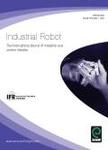版权所有:内蒙古大学图书馆 技术提供:维普资讯• 智图
内蒙古自治区呼和浩特市赛罕区大学西街235号 邮编: 010021

作者机构:Zhejiang Univ Dept Mech Engn Hangzhou Peoples R China
出 版 物:《INDUSTRIAL ROBOT-THE INTERNATIONAL JOURNAL OF ROBOTICS RESEARCH AND APPLICATION》 (Ind. Robot)
年 卷 期:2025年第52卷第2期
页 面:287-294页
核心收录:
学科分类:12[管理学] 1201[管理学-管理科学与工程(可授管理学、工学学位)] 08[工学] 0811[工学-控制科学与工程]
主 题:Humanoid robot Pose estimation Deep learning
摘 要:Purpose - This paper aims to present an unmarked method including entire two-dimensional (2D) and three-dimensional (3D) methods to recover absolute 3D humanoid robot poses from multiview images. Design/methodology/approach - The method consists of two separate steps: estimating the 2D poses in multiview images and recovering the 3D poses from the multiview 2D heatmaps. The 2D one is conducted by High-Resolution Net with Epipolar (HRNet-Epipolar), and the Conditional Random Fields Humanoid Robot Pictorial Structure Model (CRF Robot Model) is proposed to recover 3D poses. Findings - The performance of the algorithm is validated by experiments developed on data sets captured by four RGB cameras in Qualisys system. It illustrates that the algorithm has higher Mean Per Joint Position Error than Direct Linear Transformation and Recursive Pictorial Structure Model algorithms when estimating 14 joints of the humanoid robot. Originality/value - A new unmarked method is proposed for 3D humanoid robot pose estimation. Experimental results show enhanced absolute accuracy, which holds important theoretical significance and application value for humanoid robot pose estimation and motion performance testing